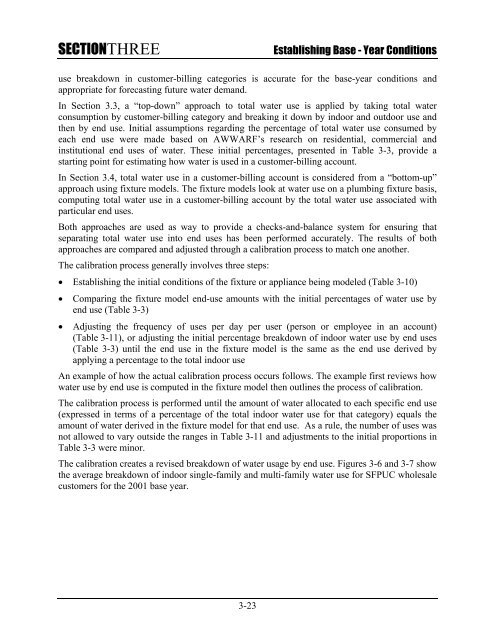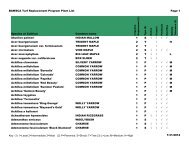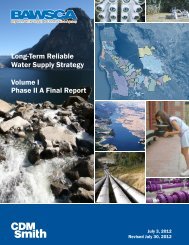SFPUC Wholesale Customer Water Demand Projections ... - BAWSCA
SFPUC Wholesale Customer Water Demand Projections ... - BAWSCA
SFPUC Wholesale Customer Water Demand Projections ... - BAWSCA
Create successful ePaper yourself
Turn your PDF publications into a flip-book with our unique Google optimized e-Paper software.
SECTIONTHREE<br />
Establishing Base - Year Conditions<br />
use breakdown in customer-billing categories is accurate for the base-year conditions and<br />
appropriate for forecasting future water demand.<br />
In Section 3.3, a “top-down” approach to total water use is applied by taking total water<br />
consumption by customer-billing category and breaking it down by indoor and outdoor use and<br />
then by end use. Initial assumptions regarding the percentage of total water use consumed by<br />
each end use were made based on AWWARF’s research on residential, commercial and<br />
institutional end uses of water. These initial percentages, presented in Table 3-3, provide a<br />
starting point for estimating how water is used in a customer-billing account.<br />
In Section 3.4, total water use in a customer-billing account is considered from a “bottom-up”<br />
approach using fixture models. The fixture models look at water use on a plumbing fixture basis,<br />
computing total water use in a customer-billing account by the total water use associated with<br />
particular end uses.<br />
Both approaches are used as way to provide a checks-and-balance system for ensuring that<br />
separating total water use into end uses has been performed accurately. The results of both<br />
approaches are compared and adjusted through a calibration process to match one another.<br />
The calibration process generally involves three steps:<br />
• Establishing the initial conditions of the fixture or appliance being modeled (Table 3-10)<br />
• Comparing the fixture model end-use amounts with the initial percentages of water use by<br />
end use (Table 3-3)<br />
• Adjusting the frequency of uses per day per user (person or employee in an account)<br />
(Table 3-11), or adjusting the initial percentage breakdown of indoor water use by end uses<br />
(Table 3-3) until the end use in the fixture model is the same as the end use derived by<br />
applying a percentage to the total indoor use<br />
An example of how the actual calibration process occurs follows. The example first reviews how<br />
water use by end use is computed in the fixture model then outlines the process of calibration.<br />
The calibration process is performed until the amount of water allocated to each specific end use<br />
(expressed in terms of a percentage of the total indoor water use for that category) equals the<br />
amount of water derived in the fixture model for that end use. As a rule, the number of uses was<br />
not allowed to vary outside the ranges in Table 3-11 and adjustments to the initial proportions in<br />
Table 3-3 were minor.<br />
The calibration creates a revised breakdown of water usage by end use. Figures 3-6 and 3-7 show<br />
the average breakdown of indoor single-family and multi-family water use for <strong>SFPUC</strong> wholesale<br />
customers for the 2001 base year.<br />
3-23







